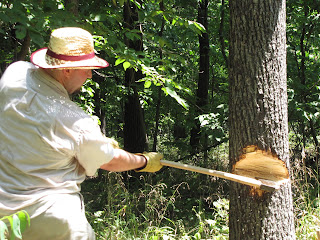This is the watermelon stage.
Watermelon with doors.
Then I layered the paint.
Did a bit of sanding...
Put screens on the doors...
Sanding detail, also, we won't use that kind of wood for anything that needs detailed jigsaw work again...
It's basically done! Just need to put the hangers on it and hang it.
One of the first questions I wanted to answer about Spice Cabinets was about their origins. When was the first Cabinet used, by whom, and what did it look like? Strangely enough the answer to all of those is a bit illusive. I can find lots of information about the history of the Spice trade, but to find information about the history of Spice storage, that is going to require a bit more digging. But digging is good for me. I'm excited to spend a part of each day digging around and learning more about how to find this type of information. I remember learning to write a research paper in ENG 210, and thinking, this is fun, and kind of easy, just a lot to read. Well, now that I'm applying those skills to a subject which has received less press, and by press I mean the usual suspects, papers, journals and the like, I find that this is going to be tricky. I will need to read up on more than just Spice and Cabinets, but kitchens and valuables and how they were kept.
So, I will give you my assumptions thus far, based on what little I have found at this point. For instance, Spices have been used in so many ways in human history, as flavoring, medicine, perfume, and currency, to name a few. Have you noticed the similarities between the Spice Cabinets pictured and the medicine Cabinet found behind many a bathroom mirror? I don't have all the evidence that I want yet, but I think that there were several obvious reasons why Spices had to be kept separate. For one thing they are pungent, and need to be kept individually to retain their potency, so the storage had to have compartments. Before the industrial age, when bottles and canisters could be mass produced, it seems that drawers where a good way to keep them separate from each other and yet in the same box or Cabinet, so as to also keep them under lock and key. I'm finding some evidence that some still use drawers for their Spices, particularly in India.
Given that Spices were valuable, at one point in time a pound of peppercorns was worth nine fat cows. I know, a pound of peppercorns is a LOT of pepper, but nine fat cow's worth? The first part of the video linked below show us a reproduction of a Spice Cabinet from early America which has two secret compartments for other valuables. I have read in many historical novels about the butler, or head manservant having the key, or needing to obtain the key from his master, to the Spice Cabinet for the household. This makes me think that the information is attainable; surely they wouldn't just make that stuff up, right? (I am grinning a bit of a Cheshire grin about this idea).
The search continues, and as it does, I keep thinking about something much more abstract, and yet possibly just as interesting. What would we keep in our Spice Cabinets? I don't mean what Spices, but if we had a Spice Cabinet that contained at least representations of what we value as highly about our lives as those of old valued their Spices, what would be filling our Cabinets? There are so many ways to go with that. Spices are and were a physical commodity, so we could look at the physical "things" in our lives that we value. And those things might also be what add a bit of "Spice" to our lives. But what I keep going back to is, what about ourselves do we value? Our courage? Strength? Compassion? What attributes or character traits do we value about ourselves, and/or want to see more of in ourselves? And how would we represent them, if we could, in our own personal Spice Cabinet?
Spice Cabinet of Early America























